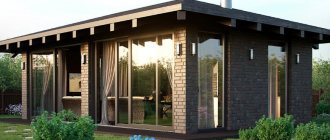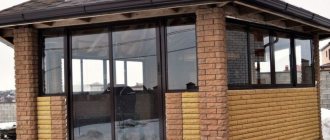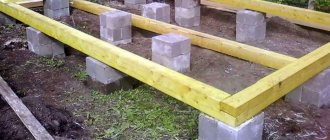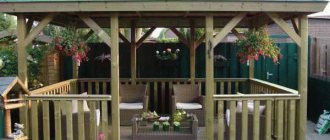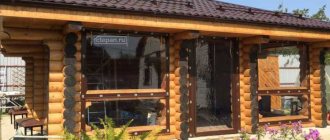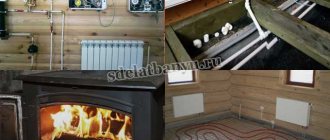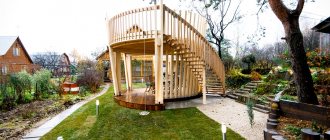Rest in the gazebo is quite often disrupted by gusts of wind or rain. It is impossible to influence the vagaries of the weather, but it is possible and even necessary to protect yourself from its consequences!
Taking refuge in the gazebo, you will once again experience the comfort and thrill of spending time at the countryside.
Idea for a gazebo
This publication will list all known methods of protecting a gazebo from rain and wind.
Some of the proposed options will only partially protect you from bad weather, while others will create an absolutely comfortable atmosphere indoors.
Frameless double glazed windows
Frameless double-glazed windows are often used to protect the veranda at the dacha from the effects of rain and snow. They have a lot of advantages. They will protect your porch from snow and rain, providing an excellent overview of the area.
She is not afraid of even the most severe bad weather. During operation, such a double-glazed window is very convenient; each element opens both inward and outward; the reliable mechanism will work for a long time. Try installing frameless double-glazed windows - you will immediately understand that this method is the best for protecting the veranda from bad weather.
The main advantage of this method is the absence of obstructions in the view. The design remains invisible and includes many advantages:
- There are no frames or racks, the glass is closely connected to each other, fastened with metal frames located at the top and bottom, to which movable rollers are connected. This allows the doors to move sideways, forming an “accordion”. This procedure can be carried out in a matter of minutes. And this is very convenient, since sometimes you need to close the terrace from the rain very quickly. At the same time, a complete overview of the surrounding area remains.
- With the help of frameless double-glazed windows, you can completely repeat the shape of the veranda, and the sun's rays will illuminate the room unhindered. A structure closed in this way for the winter will help protect the interior from bad weather.
- Such double-glazed windows are much stronger than ordinary ones. They withstand strong gusts of wind and can withstand blows from a stone or metal object, which leaves no chance for attackers.
- They are very convenient to use. Each element opens inward, which greatly simplifies glass maintenance. Street dust and dirt do not get into the hinges, which guarantees uninterrupted operation of the mechanisms.
- Thanks to tempered glass, noise from outside is reduced and the thermal insulation of the entire house is increased (if the building is closely adjacent to the building).
- The appearance of the glazed extension looks very aesthetically pleasing and improves the exterior of the home.
Hedge from the sun
As was said, all options for covering the openings of a summer gazebo are in one way or another associated with certain problems, the main one of which is that if the pavilion was originally planned as open, trying to cover it, the owner deviates from the project, and the design becomes either ugly or unreliable, or acquires both of the mentioned disadvantages.
Important! From white grape varieties on the arbor you can form Golden Muscat, Honey White or Crystal
Fans of red grapes should pay attention to varieties such as Black Pearl, Jupiter, Magic, Brown, Buffalo, Alpha or Northern Marshall. Therefore, the simplest and at the same time effective way to make your stay in an open gazebo as comfortable as possible, without disturbing the overall design concept is to plant a hedge around the perimeter of the pavilion in the form of dense ornamental shrubs, evergreen conifers or climbing plants, such as ivy or virgin grapes
By the way, ordinary grapes can be used for these purposes, you just need to choose those varieties that are suitable for growing using the arbor method.
Therefore, the simplest and at the same time effective way to make your stay in an open gazebo as comfortable as possible, without violating the overall design concept, is to plant a hedge along the perimeter of the pavilion in the form of dense ornamental shrubs, evergreen conifers or climbing plants, such as ivy or girl's grapes By the way, ordinary grapes can be used for these purposes, you just need to choose those varieties that are suitable for growing using the arbor method.
A hedge will not only create pleasant shading and coziness inside the room, but as it grows it will be able to protect people in the gazebo from summer rain and too strong winds. In most cases, such a shelter is quite sufficient, because in severe bad weather, summer residents are unlikely to want to have a picnic in the open air; it is much more comfortable to wait out such disasters in the house.
Also learn how to make and install polycarbonate sliding windows for a gazebo.
An open summer gazebo at the dacha differs from a closed one in that it is not intended to be used during rain, wind and other adverse weather conditions. For this reason, it is better to think about covering a pavilion for such occasions in advance, at the time of preparation of the project and its implementation. But if this was not done, you can protect the gazebo later, however, choosing the best option for such a solution from the many existing proposals will be a little more difficult.
Metal profile frames
You can close the veranda from precipitation in the winter using metal profile frames. This design is reminiscent of conventional double-glazed windows with cold and warm glazing. The first protect the extension only from wind, dust or precipitation. Warm glazing is suitable for those rooms that will be used as greenhouses. This method of glazing the veranda will be more expensive, but will reliably retain the heat inside. Double-glazed windows are best suited for this.
Often, verandas are glazed with ordinary double-glazed windows. This glazing has two types:
- “Cold” - is to protect the extension from the vicissitudes of the weather, since closing the veranda from wind, dust, and precipitation is important during the off-season. This option is popular because of its cost-effectiveness.
- “Warm” is an excellent way to glaze verandas that will later be used as greenhouses, since it allows you to retain heat inside. It uses double-chamber heat-saving double-glazed windows. This will allow you to arrange a winter garden or a cozy corner with a fireplace on the veranda.
Methods for covering and insulating gazebo walls
You can protect the walls of a structure from precipitation using:
- Polycarbonate. A budget option. Available in a wide range of colors on the market. It transmits the sun's rays well. However, it is worth considering that under the influence of high temperatures it begins to lose its shape. It is not recommended to use it as a roofing covering, since the sun that gets inside the building forms a greenhouse there.
- Living plants. Suitable grapes, ivy and others climbing plants. The stems tightly adjacent to each other form shade and protection from precipitation in the summer.
- Wooden gratings. Suitable for covering both the entire height of walls and their upper part.
- Blockhouse. To emphasize the contrast of the external wall decoration, a blockhouse of different colors or shades is used.
- Sun protection fabrics. They close the structure from penetration of precipitation. They are produced in the form of a fine mesh or transparent polymer material.
When covering the walls with a blockhouse, it is recommended to leave small openings near the floor, which will improve air permeability and prevent the accumulation of excess moisture.
Budget options for protecting dacha structures from the influence of the external environment save the financial resources of the owners. And with a little skill and imagination, they will become a stylish place for family relaxation at any time of the year.
Vertical awnings
Awnings protect the veranda from the sun, but can also protect it from wind, rain and snow. These structures can be open or cassette. The first ones are opened by vertically lifting the fabric, which is wound by a drum. The second ones have a similar operating principle, but they can ensure complete tightness. Both options can be installed as winter protection from snow.
The method is relatively new and is an effective and inexpensive solution to protect the veranda from wind and precipitation. The main thing is to choose the right fabric from which the structures will be made. There is an opaque base made of dralon, a special perforated one, as well as fabric with PVC inserts.
Instructions for glazing windows
Great importance is attached to the type of construction. It can be continuous or partial; in the first case, polycarbonate is installed from bottom to top.
In the second case, it assumes the existence of an obstacle. Consequently, window frames are an assembly into existing barriers.
- It is necessary to plan the placement of windows in advance and take into account their sizes. This must be reflected in the drawings of the future structure. If the gazebo has already been built, a global reconstruction will be required.
- Frames can be purchased, but they will be expensive. It's better to make them yourself. You can use wooden structures, since it will be impossible to install aluminum ones at home.
Polycarbonate is not always a good solution, because it transmits ultraviolet radiation and in the summer it can be very stuffy in the gazebo.
PVC curtains
Such protection of the veranda from precipitation is considered low-budget. It is also called soft windows. Of course, it does not look very aesthetically pleasing, but it exhibits excellent resistance to adverse factors, providing reliable protection from wind, precipitation and insects. PVC curtains are resistant to damage and are easy to install.
“Soft windows,” as this type of shelter is often called, has a number of advantages:
- resistance to the adverse effects of external factors;
- resistance to damage; ease of installation and dismantling;
- guaranteed to provide the highest protection against wind, insects and precipitation.
Among the design disadvantages it is worth noting:
- Instability to sub-zero temperatures;
- After the first frost, the film becomes covered with cracks and shrinks;
- When protected from sunlight in a closed room without ventilation, condensation begins to accumulate;
- When you buy the cheapest films, an unpleasant odor appears in the room.
Finishing with clapboard or boards
If the gazebo allows you to create a finish from boards or lining, then it is possible to completely close yourself off from any bad weather. To close the gazebo, you can use any suitable boards.
As with polycarbonate, there are two ways to close the gazebo:
Note!
Do-it-yourself garden path using a mold: a review of original and inexpensive ideas + step-by-step instructions with photos
Do-it-yourself gazebos for a summer residence - 300 photos of exclusive ideas. Instructions for building a beautiful gazebo (diagrams, drawings, foundation, roof)
How to insulate a veranda for winter living: floor, ceiling, walls. Examples of insulation from the inside and outside (instructions + photos)
- Completely close the walls.
- Do partial finishing.
In the case of the second option, you can try unusual methods, but they will not protect against wind or rain. In the first option, the gazebo will be sheltered from the weather, but from the outside it will not look aesthetically pleasing.
Fabric curtains
If you are looking for an inexpensive way to protect your terrace from rain, don’t forget about outdoor fabric curtains. This will be a fairly economical solution that can be used in the summer. Choose the highest moisture resistance class, otherwise water will penetrate onto the veranda, contributing to the formation of mold and mildew.
Dampness will penetrate the veranda even in summer, not to mention in winter. High-quality fabric guarantees water resistance, so it is best suited for an open veranda. By the way, fabric curtains can be called one of the most aesthetic methods of protection. They look great, you can choose any color that will harmonize with the interior of the veranda. If you are looking for something to cover your veranda for the summer against mosquitoes and other insects, rain, and wind, you should consider this option.
How to insulate a veranda
We tried to talk in as much detail as possible about how to protect the terrace from rain and snow. Now let's look at how to insulate it during the construction stage. Typically, stone, blocks or brick are used to build it. However, the most common option is wooden verandas. They are lightweight and quick to install. Unfortunately, this raw material absorbs a lot of moisture. Therefore, it is necessary to insulate not only the walls, but also the windows, floor, and ceiling.
The overall style of the structure depends on whether you want to make it a continuation of the house or to distinguish it from the general stylistic ensemble.
Before starting work, make a plan according to which you will do the insulation. If you are planning an open area, there is no point in insulating it. In other cases, comprehensive insulation should be carried out depending on the goals set. First, the premises are glazed, the walls are insulated, and the windows, floors, and ceilings are insulated.
The walls are treated with silicone sealant to seal all the cracks. Then the mineral wool sheets are installed in special horizontal grooves with wooden slats. An insulating film is placed over the frame, protecting the building from moisture. You can install a second frame on top. Next, the sheathing itself is installed. This way, only the outer part of the walls is insulated. For greater reliability, the interior can be coated with agents against moisture, fungus, and mold.
Construction awning
If you have a car, but no garage, then you know very well what an awning is. Such fabric is one of the most economical options when the question arises of how to cover the veranda for the winter. It is perfect for an open building and will protect it from rain or snow. A construction awning is good because it insulates the interior of the room, keeping precipitation out, but does not restrict light and air.
This fabric is not afraid of high humidity, frost or heat. It can be used at temperatures from -40 to +75. The advantage will be resistance to tearing, wear resistance, and the possibility of repair. At the same time, the material is light in weight, which is quite convenient for use. However, the aesthetics of the awning leave much to be desired. Therefore, choose what you prefer: save money on insulation, but spoil the appearance, or spend a little more, getting not only reliable, but also beautiful protection for the veranda from precipitation.
Pros:
- operated at t -40 - +75 °C;
- resistant to tearing above 70 kg/sq.cm;
- sufficiently wear-resistant and repairable;
- has little weight;
- convenient to use.
However, construction awnings have a significant drawback - poor decorative effect.
Features and stages of work
When constructing a gazebo, builders use wood, timber, stone, plastic, and brick as materials. But it is wooden gazebos that are in demand among consumers. Because they are easy to install, have a long service life and low cost.
But you need to remember that wood is not a moisture-resistant material. Therefore, to protect and use the building in winter, you need to properly insulate the walls, ceiling and flooring.
It is not recommended to carry out work on the outside of the building, so as not to spoil its appearance and finish.
To obtain high-quality thermal insulation, it is worth touching all elements of the building (floor, walls, roof), using the services of craftsmen, or with your own hands.
Protecting a wooden gazebo in winter - BeseDDkin
Wooden gazebos are incredibly beautiful, and therefore many choose them as a small architectural form for the site. Indeed, the tree is incredibly harmoniously combined with the surrounding flora, with artificial reservoirs, and with wooden sculpture. A wooden gazebo fits perfectly into the overall look of the garden area.
In the summer, guests are received in gazebos, fun dinners and celebrations are held, and the photos against the backdrop of a wooden gazebo are the most successful. They will remind you of sunny summer and hot vacation days for a long time.
But autumn comes, the gazebo begins to be used less and less. And if they do use it, it’s not so active. Meanwhile, external factors especially begin to influence the wooden structure during this period: our autumn is generous with showers, sudden frosts followed by warming, and all this cannot but affect the material from which the gazebo is built, that is, wood.
bbff20dbcba1b4ea07d55824cd978833.jpg:largeIn winter, the situation is aggravated by severe frosts, and spring again brings high humidity, temperature changes and other troubles for the structure. However, the owners of the gazebo are not entirely comfortable relaxing in it in such weather. How to deal with these troubles?
Wood processing
All wooden gazebos, a photo gallery of which is available on our website, can be treated with special compounds. Specialists can perform the treatment for a small additional fee immediately after installation. At the same time, impregnations can have different properties - protect wood from insects, reduce flammability and disinfect wood, preventing the appearance of mold and mildew. Perhaps you should not neglect any of these types of processing. Fire safety is very important, wood-boring beetles love to chew on wood even in the summer, and protection from rot, fungus and mold is absolutely necessary in conditions of high humidity. It is enough to look at a photo of a gazebo that has not been treated with special compounds, at least after a year, and it will become noticeable how the wood, once shining with the color of the sun, has darkened.
Therefore, it is better to immediately seek the appropriate service from professionals immediately after installation or do it yourself.
Painting the gazebo
no images were found
In addition, the wooden elements of the gazebo can be varnished with transparent or colored varnish
When choosing a varnish, you need to pay attention to its characteristics - the packaging must indicate whether this composition is suitable for outdoor use. If you choose the wrong varnish, then soon, at the first rains or frosts, it will peel off, and the gazebo will again become defenseless
It is worth noting that you need to paint and varnish the gazebo in warm and dry weather, when the air is not particularly humid, that is, it is better to do this in the middle of a summer day, when the morning dew has already disappeared, and the evening cool is still far away. Some gazebos, a photo gallery of which is on our website, are treated with one or another type of paint and varnish composition, and you can see how it looks externally.
How to protect the inside of a gazebo
Even if you have carefully processed your wooden gazebo and are quite confident about its safety, it makes sense to resort to another means - to protect the inside of the gazebo from rain, wind and even snow. After all, summer doesn’t end on August 31st, despite the calendar’s instructions, and on the golden autumn days you also want to treat yourself to some outdoor recreation. And in the spring, everyone strives to open the barbecue season as early as possible. But the pleasure can be spoiled by wind, rain, sleet - the weather is unpredictable. It is unlikely that anyone will want to sit on wet benches or swallow wind-blown dust.
If you properly care for the gazebo, it will repay you in kind and will always hospitably welcome you, your family members and friends under its roof.
Options for covered extensions
Before you start building an extension, evaluate all the nuances of the building itself - what style it is built in, what materials it is made of, what kind of foundation, windows, doors, and whether there is any external finishing of the building. All this must be taken into account when choosing a porch design.
So, you can perform the following options for extensions:
- The traditional wooden option is budget and practical at the same time. The porch is installed on the foundation. A large canopy protects the entrance from moisture, even if there are open fragments in the upper part where the windows are installed. This version will look great with a wooden house.
- The Russian version of the porch is a close relative of the rustic style, but with the addition of modernity and novelty. Such a vestibule-porch in a private house is necessarily made of timber or wood, and has a large number of ornaments on the facade, railings, and roof. In this option, naturalness is valued, that is, the wood is not painted with colored paints, but is left natural, natural, preserving the natural pattern. The timber is coated only with varnish for greater durability.
- Finnish style - full or partial glazing of walls, looks good with wood and brick. The design also contains forged products, which further emphasize the chosen direction. If the house is built in the Finnish style, then the porch should be small, but at the same time, in addition to wood, stone in combination with glass can be used as a building material.
- Extension made of brick or concrete. Partially or completely closed with blank walls or glazed. This vestibule is ideal for a house made of brick of the same color or stone.
Thermal insulation
Before making a decision regarding heating, it is necessary to ensure that the enclosed canopy is properly insulated. If the covered vestibule is external, then three of its walls are in contact with cold air from the street. This means that they must resist exposure to low temperatures. This can be achieved by using the right materials for finishing and insulation. For an indoor enclosed porch, only one exterior wall will need finishing. In this case, the layer of insulating material may be slightly larger than in other areas of the building. If the covered vestibule is made of rounded timber, then insulation may not be needed at all if the log is sufficiently thick.
When insulating a covered porch, you can use extruded polystyrene foam, regular polystyrene foam or stone wool. For the latter, you will need to use a vapor barrier on both sides to protect the insulation from cotton wool. Some types of wool absorb moisture and lose their properties, due to which the thermal insulation properties may disappear. Regarding extruded polystyrene foam, it is worth remembering that insulation with it should not be carried out from the inside, since this will lead to even greater accumulation of moisture inside the covered porch. The consequence will be not only frost, but also mold and mildew.
How can you close the openings of open verandas? Protection methods that require significant investments
Closed gazebos and terraces can be protected using metal profile frames. This is done using two methods. Cold is used to glaze a building for the winter. To avoid problems with ventilation in the spring and summer, it is necessary to install a sufficient number of sashes. You can install them yourself.
Despite the costs, the owner of the home and surrounding area will receive a reliable structure that will last for a long period of time.
The warm glazing method is suitable if the gazebo is used throughout the year. In this case, double-glazed windows must be used. They save heat indoors.
Practical people often prefer frameless double-glazed windows. The gazebo, which is protected in this way, will receive the maximum amount of ultraviolet rays. Additional bonuses include:
- expansion of the viewing area;
- strength;
- saving electricity;
- Ease of use;
- protection from mechanical stress and adverse weather conditions;
- heat preservation;
- sound insulation.
The double-glazed windows fit tightly to the wooden parts and at the same time clearly repeat their shape at the points of contact. Due to the light weight of the material, the installation process will not take much time. You can deal with it on your own.
Expensive materials include roller shutters, which can be made of different materials.
Read the article about curtains, curtains and blinds for gazebos.
Suitable materials
Today, the range and price range of building materials make it possible to choose the best option for preparing a structure for winter. Conventionally, gazebos are divided into:
Therefore, when choosing materials, it is worth considering the type of construction.
Metal frames
They are used for glazing gazebos and closed terraces.
Depending on the functions performed, there are 2 types of glazing with metal profile frames.
- Cold. Its main task is to close the gazebo or veranda for the winter from the effects of environmental factors in the form of precipitation, gusts of wind, and dust. But when ordering and installing double-glazed windows, you need to ensure that they have a large number of sashes. After all, if there are none, then in the warm season a real bathhouse will form in the gazebo. Therefore, this is a good budget option for protecting the structure in the spring and summer.
- Warm. The type of glazing assumes year-round use of the building. The material used is double-chamber double-glazed windows, which have a heat-saving effect. Owners of country houses set up a winter garden or install a fireplace on such a veranda or terrace.
However, a warm type of glazing should be chosen only if the room needs to be constantly provided with heat.
Construction awning
A simple and cheap way to protect against snow and rain is to use a construction awning, which is suitable for gazebos and open-air terraces.
The film is a durable material that can easily withstand sudden temperature changes and excessive humidity. She doesn't get wet. However, it does not allow sunlight to enter the room. The recommended temperature range for use is from -40 to +75 0 C. The film is wear-resistant. In case of a breakthrough, you can apply a patch or seal it. Quite light in weight. The edges of the awning are equipped with metal rings, which are used to fasten the material to the surface of the structure.
2494d0039bed3532229977eb5da9fe91.jpg:large
The only drawback of the awning is its unaesthetic appearance, so lovers of design solutions and decoration should pay attention to other options
Sheer PVC curtains
An inexpensive type of protective cover for gazebos or terraces, the properties and technical characteristics are similar to a construction awning. Due to its light weight, it does not cause difficulties during installation. Curtains will protect from gusts of wind, snow and insects.
But we must not forget about the need for ventilation inside in order to avoid the formation of a steam room.
The main disadvantage of PVC shelters is its instability to low temperatures. During frosts, stretched curtains begin to crack and narrow, and breakouts may appear. Not recommended for use in regions with frosty winters.
Frameless double glazed windows
Such a stylish building shelter, in addition to its unusualness, has many other practical advantages:
in a room glazed in this way, the maximum amount of sunlight penetrates, thanks to which the gazebo will become bright, and you can significantly save on energy costs; double-glazed windows have increased strength, so you should not be afraid that throwing a stone will damage a wall or window; protect from snow, rain, wind and street dust; the viewing area of the territory expands; custom-made double-glazed windows clearly follow the shape of the building; the doors open to the side. the material fits tightly together, due to which it retains heat well inside the building; they weigh little and are therefore easy to use; create sound insulation.
Home owners who want to emphasize the aesthetics and modernity of their summer cottage should opt for this material.
However, the price of the structure is not cheap. A square meter of movable double glazing ranges from $150.
Vertical awnings
They are a novelty among building materials. Their main purpose is to protect the building from the influence of environmental factors.
Awnings are produced in two types.
Cassette - guarantee the tightness of the room. They move in a U-shaped direction. Resistant to gusts of wind. Open - by rotating the drum handle, the lowered protective fabric is raised. When closing, the opposite situation occurs.
Awnings have not found widespread use among consumers, so they can only be seen on designer structures.
Project
A type of closed extension is a porch with a vestibule. This is a design of a small area, most often 3X4 meters, which provides a comfortable microclimate of the home. It will look good with both a one-story house and a cottage. The vestibule can be made as a small separate house, in the form of a square, an extension with a transition to a glazed veranda, elevated with stairs or above ground. It is located both in the center, at the main entrance, and on the side, at the back.
As a rule, the porch is formed on the foundation. For walls, choose brick, wood, rounded timber, concrete slabs, stone, blocks; they can also be partially or completely glazed. The selected material should be similar to the material of the main building. Timber is selected for houses made of logs and slabs. Brick steps are suitable in most cases, but wooden planks can be used everywhere.
The difference between this design and the others is that this porch looks like a small room - it has a floor, walls, windows, a door and a roof. It can be insulated and illuminated and used as a hallway.
If you like to do everything with your own hands and understand construction, then building a porch on your site will not be difficult. Its design can be different, the main thing is that the vestibule is combined with the main supporting building.
Camouflage (camouflage)
Camouflage or camouflage netting has long been used not only in military affairs.
Previously, tanks, weapons, and dugouts were covered with camouflage weaving. Such a shelter was difficult to detect with the naked eye from a long distance. Today, a camouflage net can be used to cover a gazebo, thus creating the effect of an enclosed space. In addition, such a shelter will merge with the grass and trees and become part of nature.
Important! Under constant, prolonged exposure to ultraviolet radiation, polyvinyl chloride may lose its strength and elasticity. For this reason, a special protective layer is applied to PVC
Therefore, it is important not to remove it when cleaning the canvas.
Today, camouflage nets are one of the most popular types of shelters for gazebos. After all, they provide excellent protection from the sun’s rays and unwanted neighbors’ views, are relatively inexpensive and allow you to compactly cover a gazebo of any size and shape.
It is important to note that camouflage nets are divided into 2 types (relative to the basis on which the production takes place):
- polymers based on nylon;
- material that does not have a special reinforcing base.
It should be understood that the service life of the first type of shelter is much longer than that of the second. Accordingly, the price of a polymer-based network will be higher.
If we talk about the positive and negative qualities of such shelters for gazebos, then it should be noted that there are many more advantages than disadvantages. Pros of a camouflage net:
- relatively low price;
- Possibility of purchase at any fishing or hardware store;
- ease of operation (you can cover the gazebo in just a few hours);
- high percentage of shading;
- polymer networks are resistant to high humidity and frequent rain.
Is heating necessary?
This question regarding the design of a covered porch can be left to the discretion of the owner. Some argue that heating for such a room is necessary due to the fact that it is not a direct part of the house and in winter condensation can form inside due to temperature changes and become frost or ice. There is also an opinion that with strong cooling, the covered porch ceases to be a buffer, because the temperature in it drops to the street temperature. But if you bring the radiator from the main heating circuit into the covered porch, a difficult situation may arise. If the heating stops functioning for some reason, the external radiator can cause the entire system to fail. Media consumption will also increase significantly.
You can solve the issue regarding heating with good insulation and then you won’t have to worry about there being a big difference in temperature. It is easy to install a small autonomous electric convector in a covered porch, which will turn on according to a given mode. Set its operating temperature at 14 degrees and leave it as is. There is also the option of installing film or cable heated floors. It should be understood that the first one cannot be laid under the tiles, so on the covered porch you will have to use another flooring or cable heated floor. The advantage of this solution is the quick drying of outdoor shoes, which previously had to be done near heating devices.
